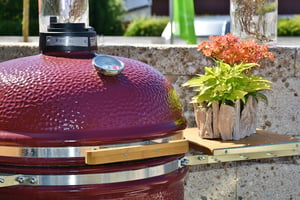
You may have seen one of those unusual ceramic grills at a friend’s house—the kind that looks like a little spaceship or a giant egg on a tripod. (One brand name is even called the Big Green Egg.)
This backyard appliance is called a kamado grill, and it can function as a grill, smoker, and pizza oven all in one. It’s slightly different to work with than your typical grill, but the results can be amazing.
If you’re thinking about adding a kamado to your outdoor kitchen, here’s a general overview of what it can do.
Kamado basics
A kamado grill is a ceramic or clay stove fueled by charcoal for smoking and grilling. It retains more moisture than a typical grill, making for juicier results, especially for smoked or roasted meats.
Technically, a portable kamado is called a mushikamado, to distinguish it from a kamado that is a permanent fixture of a traditional Japanese kitchen. It was originally used to steam rice but has a number of versatile uses for the outdoor kitchen, including smoking, baking, grilling, and more.
A kamado grill can heat up to 1,200 degrees Fahrenheit—which is much too hot for most outdoor cooking applications! You can control the temperature by opening and closing the draft door at the bottom of the egg (to allow air into the fuel section) and adjusting the vent at the top of the egg.
The more airflow you allow, the higher the temperatures rise.
Most kamados have an easy-to-read thermometer right on the front of the unit, so you can adjust the openings until you reach the right heat for the type of food you’re planning to prepare. Keep in mind, though, that it’s easier to heat a kamado up than to cool it down, so don’t let the temperatures get out of hand.
Fuel
Most manufacturers recommend lump wood charcoal, since charcoal briquettes can negatively affect the flavor of food in this enclosed, high-heat environment. Fortunately, kamado ovens are quite fuel-efficient and lump charcoal leaves little mess to clean up. Some traditional kamados can use wood, but models that do this are rarer to find in the U.S.
Don’t use lighter fluid or any other fuel with a high chemical content, since these fumes will be trapped in the oven and will impart an unpleasant taste to your food.
Grilling on a kamado
Most American kamado ovens come with a familiar grill grate (and some come with a second elevated grate that fits over the first for another tier of grill area). You can adjust the temperature to cook on it like you would a normal grill, or you can turn up the heat to get a nice sear on steak or pork.
For grilling burgers, fish, or other items where it helps to have both direct and indirect heat zones, use a ceramic deflector plate (typically in half-moon shape) to moderate the heat on one side of the grill.
You can also use the kamado’s prime smoking environment to add a little woodsy flavor (such as Steven Raichlen does with these spruce-smoked steaks).
Roasting or smoking in a kamado
Kamado grills are excellent for low-and-slow cooking and maintain more moisture than conventional grills. Use a round ceramic “smoking stone” (or two of the half-moon ceramic deflector plates) to ensure indirect heat and to increase the amount of smoke in your kamado.
A few of your many options include:
- Smoked pork barbecue
- Spare ribs
- Roast beef
- Beef brisket
- Smoked ham
- Smoked chicken
- Roast chicken
- Roast turkey
- Tandoori-style chicken
Baking bread and pizza
Because of the kamado’s oven-like properties, combined with its ability to reach high temperatures, it’s easy to bake crispy pizzas or even loaves of bread inside. You’ll likely need a pizza stone plus a deflector plate (or firebricks) to raise the cooking surface for ease of access, as well as to ensure indirect heat for an even cooking temperature.
Are you ready?
Whether you’re looking to design an outdoor kitchen that includes a kamado grill, or you’re just looking for a top-quality traditional grill, the experts at Unlimited Outdoor Kitchen can help you choose the appliances and finishes that are right for you. Give us a call at 888-7-Grill-It!

